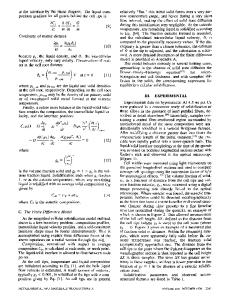A three-dimensional cellular automation-finite element model for the prediction of solidification grain structures
- PDF / 2,208,025 Bytes
- 13 Pages / 612 x 792 pts (letter) Page_size
- 99 Downloads / 342 Views
UCTION
A two-dimensional (2-D) cellular automaton (CA)–finite element (FE) model has been proposed by Gandin and Rappaz for the modeling of dendritic grain structures formation during solidification.[1] This 2-D CAFE model was validated on the basis of numerical tests performed on simple heat flow configurations, e.g., Bridgman-type cooling conditions (fixed thermal gradient and cooling rate). These tests were complemented by the comparison of the predicted envelopes of single dendritic grains with those calculated from analytical solutions.[2] Experimental validations were also carried out using in situ observations of the Bridgman solidification of transparent analogues. The 2-D CA algorithm was shown to reproduce well the growth competition occurring among columnar grains.[1] Good agreement was also obtained for the extension of a single dendritic grain into a lateral region of liquid past a re-entrant corner.[2] The predicted columnarto-equiaxed transition using the 2-D CAFE model was finaly compared with the grain structure of an aluminum - 7 wt pct silicon alloy, which was unidirectionally solidified. As a result of these various validations, it was concluded that (1) the 2-D CA growth algorithm is indeed able to account for the physical mechanisms involved during dendritic growth (e.g., influence of the dendrite growth direction on the tip ´ Ch.-A. GANDIN, formerly with the Laboratoire de Metallurgie Physique, ´ ´ ´ ´ Departement des Materiaux, Ecole Polytechnique Federale de Lausanne, Switzerland, is with the Ecole des Mines, Parc de Saurupt, F-54042 Nancy, France. J.-L. DESBIOLLES, Staff Member, and M. RAPPAZ, Professor, are ´ ´ ´ with the Laboratoire de Metallurgie Physique, Departement des Materiaux, ´ ´ Ecole Polytechnique Fe de rale de Lausanne, CH-1015 Lausanne, Switzer´ land. Ph. THEVOZ, Executive Director, is with Calcom SA, PSE-EPFL, CH-1015 Lausanne, Switzerland. Manuscript submitted April 14, 1999. METALLURGICAL AND MATERIALS TRANSACTIONS A
undercooling, grain competition at grain boundary, etc.); and (2) the 2-D CAFE model can predict satisfactorily the grain structures formed in various solidification processes such as the investment casting of turbine blades, the continuous casting of rods, and welding.[3] Despite the new insight brought by the 2-D CAFE model into the modeling of solidification grain structures, a threedimensional (3-D) model had yet to be developed in order to predict quantitatively real as-cast structures. Indeed, the 2-D model could reproduce neither the intricacy of grain structures seen in transverse sections of thin “equiaxed” plates or airfoils nor the evolution of the crystallographic texture associated with the selection mechanisms of columnar grains. This problem was partially overcome by considering a preliminary 3-D extension of the CA model, yet limited to uniform temperature situations and simple geometry.[4,5,6] But a general extension of the CAFE model to 3-D heat flow situations in real casting geometry had still to be made. A major step in this direction was
Data Loading...











